Ghosts Of The Future: Borrowing Architecture From The Zone Of Alienation
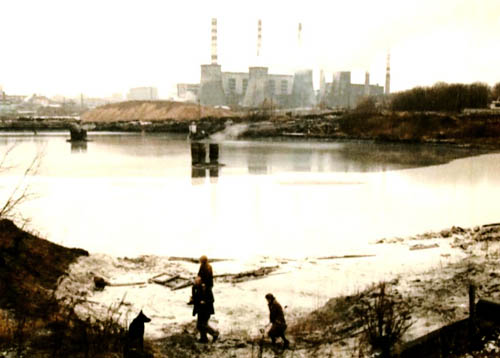 [Image: From Stalker, directed by Andrei Tarkovsky].
[Image: From Stalker, directed by Andrei Tarkovsky].[Note: This is a guest post by Jim Rossignol].
During the period in which 3D videogames began to use textures imported from photography, rather than hand-drawn pixel tiles, it became common to hear game developers discuss their photo references.
Drew Markham, director of Return To Castle Wolfenstein, spent the 2001 pre-release press tour for his game talking about the time he had spent in Europe, sourcing textures from "real" locations that had played host to the war. Crumbling French flagstones, Teutonic concretes, and other useful built surfaces: these details would add a certain level of authenticity that other games lacked. When the Wolfenstein sequel finally arrived, British gaming journalists were amused to see the ubiquitous British "H" fire hydrant signs scattered deep within the occult bunkers of Himmler's SS Paranormal Division.
 [Image: Photo by Jim Rossignol].
[Image: Photo by Jim Rossignol].A few years later, another photo-reference tour was being cited for the gaming press, only this time it was not a cheery holiday in Europe, but a trip to the Zone Of Alienation. This 30km area of Ukraine and Belarus remains poisoned and largely off-limits to mankind, thanks to the radioactive caesium that dusted it after the explosion at the Chernobyl Nuclear Power Plant in 1986.
While it has remained quarantined and closed to (legal) habitation, it hasn't kept out sight-seers. The production team at GSC Gameworld, a games studio based in nearby Kiev, intended to use the derelict zone as the basis for environments in their action shooter, STALKER: Shadow Of Chernobyl. The team went into the zone and photographed urban dereliction: a snapshot of an abandoned Soviet Union. They would go on to fill their game world with the zone's rusting fences and collapsing grain silos, but that was not all that came with the material: the landscape and its decaying architecture was already charged with mythology—with narrative.
Creative director Anton Bolshakov explained this in an interview in 2007: "The Soviet system was sealed, many facts were kept secret. Even the most harmless objectives or events generated unbelievable rumours and legends." One example, he says, is
- an existing gigantic antenna located within the Chernobyl exclusion zone. On some of our photos taken during the trip to Chernobyl the body of the antenna is seen on the horizon spanning several hundred meters across. So some unofficial sources claim, the waves emitted by the antenna were psychoactive. The antenna was directed onto Western Europe and preoccupied with a long-lasting military experiment on psychotropic influence onto human psyche.

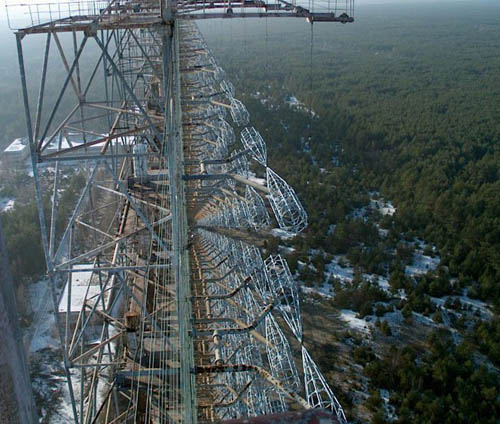

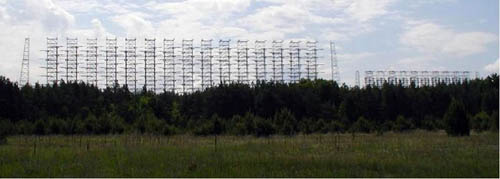 [Images: The "steel giant" near Chernobyl; all photos via English Russia].
[Images: The "steel giant" near Chernobyl; all photos via English Russia].The antenna wall—actually an early-warning radar system developed for Cold War defense, which has been preserved thanks to being inside the zone—made it into the game as "the brain scorcher," a device that must be shut down before the player can progress into the abandoned city of Pripyat. The environment of Chernobyl not only provided the game with an authentic atmosphere, it was also to influence the events that players could experience.
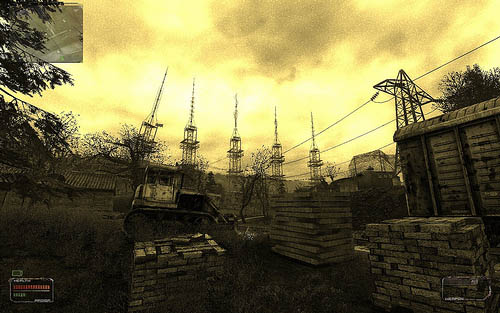 [Image: The "brain scorcher," via Jim Rossignol].
[Image: The "brain scorcher," via Jim Rossignol].However, the zone as an idea already existed before the explosion in 1986. It appeared, for instance, in a 1972 science fiction novel called Roadside Picnic. A mysterious, contaminated pocket of landscape, quarantined from the outside world, was the main theme of that book, which was written by two brothers, Boris and Arkady Strugatsky.
In the Strugatsky's book, an alien visitation to the earth—an extra-terrestrial "roadside picnic"—has left dangerous and incomprehensible materials strewn across a zone of Northern Canada. Although sealed off for scientific research, this zone is raided by "Stalkers" who sell the unnatural trinkets for black-market cash. To do so, they brave bizarre dangers, because the zone has been transformed into a place that is utterly at odds with our own world. The alien is never seen or even described, and all the characters encounter is its terrible remainder: landscape made alien. Pools of jelly that will cripple a man lurk in basements, extra-terrestrial cobwebs that can stop a heart beating are strung across doorways, and gravitational mantraps will crush anyone who passes over the wrong patch of mud.
The zone of Roadside Picnic was seen by many as an allegory for the entire Soviet experiment: not simply in the literal sense of the poisoned landscapes created by the industrial excesses of the region, but the entire social order that was created by the Communist government. Polluted expanses, continually washed by acid rain, became shorthand for describing the bizarre political situation of a country in which Communism had failed, and yet robotically continued.
Russian film-maker Andrei Tarkovsky shot a movie, called Stalker, which told a story based on that of Roadside Picnic. A glacially slow, almost event-free film about landscape and longing, it's a work that lingers for long minutes over broken wastelands of abandoned industry. It encapsulates Tarkovsky's style, as well as his interest in dereliction and decay—themes that would be revisited by the STALKER videogame, thirty years on.
 [Image: From Stalker, directed by Andrei Tarkovsky].
[Image: From Stalker, directed by Andrei Tarkovsky].Tarkovsky's film manages to imbue derelict industrial landscapes with a terrible sense of threat. Largely unable to realize the alien properties of artifacts in Roadside Picnic, Tarkovsky projected the danger into the architecture itself. Passive landscapes that could swallow a man. Tunnels which tear them to shreds. These effects were never demonstrated, but also never doubted, thanks to the tentative way the actors explored their surroundings.
In much the same way that the images of the real Chernobyl zone seem like lush vegetative scenes, despite being formidably radioactive, so Tarkovsky's zone is calm and invisibly dangerous.
Cinematic legend had it that the power station shown in the final background scenes of the film was in fact Chernobyl NPP, although the truth is the entire film was shot in Estonia. That's not to say that Stalker was without poisonous consequences of its own, however. The first version of the movie was shot entirely on corrupted film, which was unsalvageable when Tarkovsky's production team returned to their Russian studios. Worse, the second shooting took place down stream from a poorly regulated chemical works. The effluent from the plant was responsible for many of the astonishing visuals in the river scenes from the movie, but team members came to suffer serious side-effects from this exposure, including cancer. They had, it seems, suffered side-effects from their time in the zone: just like the fate of the fictional Stalkers in the Strugatsky books. It was as if the fiction and reality were blurring back through each other. As if—to quote Alan Moore—the written page was too fragile a boundary.
Or perhaps, as Steven Shaviro suggests in his book Connected, Roadside Picnic, like all science fiction, actually exists to cast a shadow over the present. "It shows us how profoundly haunted we are by what has not yet happened," says Shaviro of science fiction writing. In the specific case of Roadside Picnic and Tarkovsky's film, what had not happened yet was the Chernobyl disaster.
After 1986, however, there were others for whom the ideas of Roadside Picnic were to be immediately accessible and useful in describing the world that they faced. People going into the Chernobyl exclusion zone, to loot buildings or show tourists around, began to call themselves "Stalkers." For them, the zone of the Strugatsky's vision was immediate and first-hand, a kind of fictional reference for the reality they were facing. They were living it—and it was strangely convenient to have the Stalker nomenclature to hand.

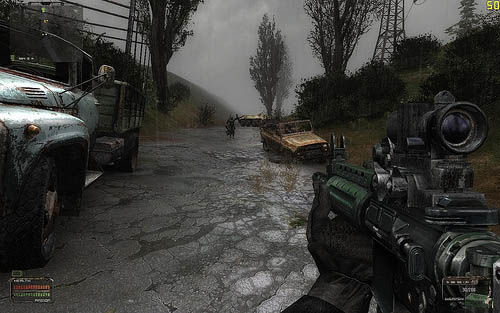
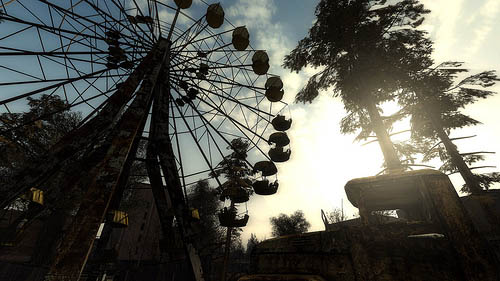
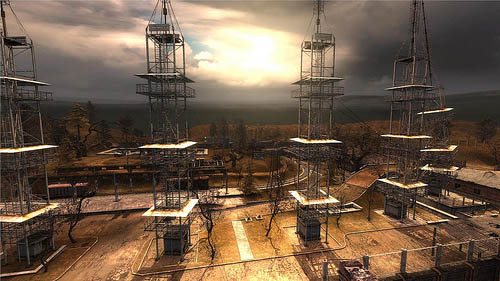 [Images: STALKER game images from this very extensive Flickr set].
[Images: STALKER game images from this very extensive Flickr set].As for Bolshakov and his creative team, borrowing from both the Strugatskys and the real world has proven fruitful. Real world ruins seem to connect with players far more readily than their fantasy counterparts. No one has been able to come away from STALKER without talking about the architectural waste that GSC borrowed from the zone. The game has now reached three iterations and supports an energetic fan community.
Bolshakov suggests that there is more to this than simply commerce or escapism, however: "The motif behind STALKER was to create a game which would remind people of the Chernobyl accident and at the same time warn mankind against any possible fatal mistakes in the future." The warning seems likely to go unheard, but perhaps it has another message: to tell game developers that the architecture of the real world comes prefixed with meaning. Even now, when cities can be raised procedurally from the blank canvas of a game engine, perhaps it's worth taking a look at the real world and the mythology that has been strewn around it. If borrowing architecture from the zone proves anything, it's that simulation should not exist in a vacuum.
Jim Rossignol is a games critic, blogger, occasional guest writer on BLDGBLOG, and author of the excellent This Gaming Life: Travels in Three Cities, published by the University of Michigan Press. He is @jimrossignol on Twitter.





Comments are moderated.
If it's not spam, it will appear here shortly!
Thank you, Jim, for this wonderful piece. BLDGBLOG and RPS are two of my favorite sites, so you can imagine the surprise when I discovered this crossover! STALKER is remarkable for the narrative buried in the environment (far more engaging than the narrative of the games). I only hope that cryengine to be used in the true sequel enhances the atmospheric experience, rather than simply adding a shiny veneer, and bells and whistles.
I also logged in to thank you about the article. "Roadside Picnic" was one of the first science fiction books which I really liked and I must admit that I have read it several times during the years, each time getting more of the plot. (It happens when you read things when you're twelve.)
I admit that my love for rust, cracking asplhalt and abandoned places rose from the descriptions of the book.
Tarakovsky's "Stalker" was too much for me on the first viewing (I was 15 probably), but has grown on me and I rate it as highly as the book.
So the S.T.A.L.K.E.R was a thing I (literally) waited for years and as someone from the former Soviet block (Estonia): the whole architecture in Ukraine was utterly standardized so I got to be nostalgic about some concrete fences and small checkpoint houses, which got the "exact right" childhood window bar designs... I didn't enjoy the plot of the game: I just trespassed whenever I could: the buildings had lots and lots of places I could climb and they didn't reward me with any stuff or ammo: they were their own rewards. I could spend hours climbing half-built buildings, overlooking abandoned train-yards or just admiring rusty cars from my childhood.
In a way the game was a flashback into my Soviet childhood: fading and rusting memories and architecture.
BTW: if anyone ever happens to visit Tallinn: the long brick chimney near the port was used for the "Stalker" movie and the letters: UN can still be seen on it (there are several chimneys near the port but the one you are looking for is towards the Old Town and NOT the city centre).
Interesting article. I love the look of the Stalker-games, and I would really love to see the GSC-team do a Fallout-game. They do post-apocalyptic right.
Your Wolfenstein-example was amusing, by the way, because I remember it for a similar thing: The game featured a number of nazi propaganda posters, which were 100% authentic. The only problem is, several of them weren't German. Instead they were recruitment posters from nazi-occupied Norway (fight the soviets, save the world from communism, et.c.), written in Norwegian. The game had a level set in Norway, which is probably why they ended up in the game in the first place, but they were also found in many German locations in the game. Which obviously made no sense at all.
Thanks for the post, I've spent a lot of time in Chernobyl within the Zone. I've made a little film, or homage, to Tarkovsky featuring the 'Stalkers' who still live and work within The Zone. Please have a look. What's interesting in Tarkovsky's Stalker, and with Chernobyl today, is how the landscape becomes a parable for terror. (Ecological, political, psychological, etc.) Fascinating and terrifying.
http://www.vimeo.com/8302512
Regarding the hydrant signs, can we really be sure they're as mundane as they seem? How do we know they're not occult signifiers hiding in plain sight? That H could be the Elder Futhark rune Haglaz which we're told "symbolizes raw elemental power arriving in
the form of disruption". Could this explain the proliferation of mysterious pits in Britain's roads? Maybe Drew Markham was onto something...
An other fascinating SF by the Strugatskii brothers, whose novels and stories are very highly esteemed in the russian science community. (Here it's summary, Trailer, filmsite, wiki on the novel)
You know what, Rossignol, you may have found the answer to my long-time, dilemma of "what is it about STALKER that just gets me". The whole mythos of the Zone, Chernobyl and the Cold War has been churning around in my brain for far too long without reason, and then I realised just what an impact the actual history surrounding the zone had on me when I was playing. There's something engrossing about it, something unpeaceable, and feeling as if you're not only within the games mythology, but that of the real world only makes it more believable and immersive.
A great write-up, I'm really enjoying your pieces here.
Just wanted to say one sole thing: The parallel between the radar and the brain scorcher is kinda interesting, but false.
In fact the brain scorcher do is a fictional device, that has been entirely made-up for the game, and is not in the same place than the radar, which is actually shown in the "Clear Sky" prequel to the stalker video game.
I don't play video games, but maybe I should start. This is one of the best cultural critiques I've read in some time.
I actually did some additional background research to learn that STALKER, the game, is actually a product of Ukrainian programmers. I was in western Ukraine last fall, and the entire country has a bit of a post-apocalyptic feeling about it, with all sorts of crumbling Soviet infrastructure and a general sense of pessimism. How appropriate that the country's video game producers are capitalizing on the same physical/cultural ruins, like stalkers themselves.
Always impressed. A very fine article. Nothing can be more exciting then the abandoned. Continue the great work my friend.
To me what makes Roadside Picnic and Tarkovsky's Stalker such great works is that the dangerous anomalies are set beside man's more dangerous assumptions that not only can reality be mapped, but that he has it firmly tied down.
To do these narratives justice, the game itself should be continually changing and shifting in structure on a meta level so that strategies that worked before no longer apply, and the terrain continually shifts its "psychotropic" topologies. It does it somewhat, from what little I have seen (my boyfriend plays it). However, in the movie and short story, the stalker character has to respond to the landscape as a set of near-sentient entities that may or may not allow passage.
Unfortunately, in the game, the player and non-player characters have far too much armour and weapons as well as a soldier's set of reality assumptions. In both the book and the movie that would guarantee getting killed off by the anomalies. The looser relation to reality conventions and the torment of having to maintain a degree of madness to creatively respond to the zone is one of the reasons Roadside Picnic and Stalker are such gems.
The decay and creepiness are lovely windowdressing, for this. I think on a wider level, these types of feral, contaminated landscapes are indeed the future, given the way things are going. If the game can prepare us for it, great. But there are many many zones to get out there and explore, and every time we step into an abandoned industrial zone, a careful negotiation of the terrain is required. And that has its own rewards.
Hi,
Good post. I've always admired your writing as do most of my friends (proof: someone has nicked my copy of This Gaming Life).
Just writing to express a few thoughts. As a game studies scholar, I have worked extensively on the STALKER games and am probably one of the first people to have done a critical / philosophical analysis of STOC and Clear Sky. I think the 'Zone' represents the 'space of possibility' of all videogames and is. therefore, a metaphor for time and space in videogames. The French philosopher Gilles Deleuze discusses Tarkovsky in his Cinema books and also talks about an affective zone called 'any-space-whatever'. Reading about Tarkovsky's Stalker in his book Sculpting in Time and then comparing the Zone in STOC can be interesting. I've written extensively about this and have been very kindly published by the Uni of Potsdam (opus.kobv.de/ubp/volltexte/2008/2463/pdf/digarec01_13.pdf).
What intrigues me, however, is that none of the posts mention the story of STOC. The whole Strelok story where the protagonist finds out that he is asked to shoot himself is quite fascinating. Incidentally, 'strelok' in Russian means 'shooter'.
Anyway, I'm probably getting carried away. COD 4 also has a Pripyat setting which, although good in its own right, kept reminding me of STOC. I could almost feel the absent fragrance (like the Stalker in Tarkovsky), expect anomalies to scorch me and be scared of the many unknown dangers of the Zone.
Call of Pripyat is lying unopened on my bookshelf. Time to install and play.
Souvik
Do you know that Tarkovsky made his movie LONG before Chernobyl tradegy?
To do these narratives justice, the game itself should be continually changing and shifting in structure on a meta level so that strategies that worked before no longer apply, and the terrain continually shifts its "psychotropic" topologies. It does it somewhat, from what little I have seen (my boyfriend plays it). However, in the movie and short story, the stalker character has to respond to the landscape as a set of near-sentient entities that may or may not allow passage.
tamashebi
Post a Comment